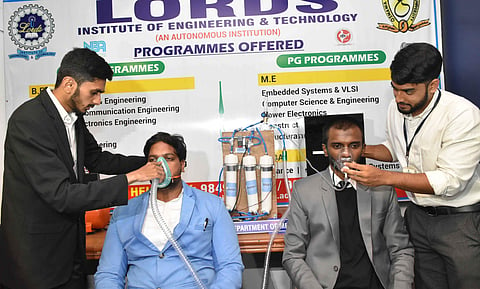

People losing their lives due to lack of oxygen is the worst havoc that COVID wreaked and this is the problem Shaik Mohammed Rayyan wanted to tackle as his project. Thus, the final year student of Lords Institute of Engineering and Technology got to work in April 2021 and he and his team of 11 gave this problem statement three months. The result? An oxygen concentrator that can pump out 25 litres per minute. That's a lot!
"Actually we were aiming for ten but the air compressor we used made all the difference as it was able to set aside extra oxygen as a reserve," says 21-year-old. Not only can it be used by two people at a time, but it is also made from water purifiers.
Silica gel and zeolite — these are the two star ingredients that work in the favour of this project. Once the RO candles of the water purifier are removed to be replaced with Pressure Swing Adsorption (PSA) which absorbs the air from the atmosphere, silica gel cools the temperature, separates the gases (air consists of 78% nitrogen, 21% oxygen and 1% other gases) and removes the impurities while zeolite separates nitrogen and oxygen, traps the former and lets the latter flow. "When we were working on the project, zeolite was not available in the market but with great difficulty, we got our hands on zeolite (13X) pellets," says Rayyan. Plus, solenoid walls ensure that using the principles of electromagnetism the constant air pressure is maintained without any drops.
Availability, cost-effectiveness, easily repairable and components should be easy to procure — these were the four factors the team had in mind at all times while working on the concentrators. "The oxygen concentrators are expensive and so are their parts. If it breaks down, it is a costly affair to get it fixed. That's why we wanted our device to be affordable and the availability of all the parts was also an important factor," says the youngster who was born and brought up in Jeddah, Saudi Arabia. One particular bottleneck they faced were being civil engineering students, coding was not something that came naturally to them. Hence, they made optimum use of an open-course oxygen concentrator design kit put out by TCS and Prof Nithin Chandra Manas was of a lot of help to them.
So from being someone who wasn't aware of what an oxygen concentrator does to making one, this has been quite the journey for Rayyan who calls himself an average student. "Frankly, this oxygen concentrator, priced at Rs 20,000, is the best thing I have ever done in my academic life," says the student with a huge grin. He sincerely hopes that pending approval from ICMR, they are able to take this device forward and see to it that it benefits more and more people. As far as academics goes, Rayyan hopes to be off to Canada to pursue higher education and work in the automobile sector in the future.
What's an oxygen concentrator?
- A medical device that uses air from the atmosphere, separates oxygen from other gasses and supplies it
- Usually, the device has compressors, filters, a tube, a face mask or a nasal cannula
- These concentrators can be used by mild to moderate COVID-19 patients
- They are both stationary and portable and can supply five to ten litres of oxygen per minute
For more on them check out lords.ac.in
